PV Energy Communities in Residential Apartments: Technical Capacities and Economic Viability
Abstract
1. Introduction
2. Background and Research Objectives
2.1. Experiences with PV Sharing in Residential Communities
2.2. Situation in Latvia
2.3. Research Objectives
- What are the technical options and limitations in establishing PV communities in typical apartment buildings?
- What are the economic effects from consumers’ perspectives of changes in legislation, i.e., the transition from net metering to net settlement?
- How economically viable are PV communities in typical apartment buildings?
- How does electricity market price affect the economic benefits of PV communities in typical apartment buildings for the PV community members?
3. Materials and Methods
3.1. General Description of Case Studies
- Scenario 1 corresponds to the participation of 25% of the units;
- Scenario 2 corresponds to the participation of 50% of the units;
- Scenario 3 corresponds to 100% when all units invest in the PV system.
3.2. RES Connection Options and Technical Limitations in Typical Apartment Buildings
3.3. Consumption Profiles
3.4. Generation Profiles
3.5. Methodology for Economic Analysis
- Pgi—active power generated during i-th month;
- Pli—active power consumed during i-th month.
- —cash flow in the year t, i.e., consumer benefits compared to no PV scenario;
- t—year;
- r—discount rate.
4. Results
4.1. Technical Options for Establishing ECs in Typical Residential Apartments
4.2. Evaluating the Impact of Transitioning from Net Metering to Net Settlement System
4.3. Evaluating the Economic Viability of ECs in Typical Apartment Buildings
4.4. Sensitivity Analysis—How Electricity Market Price Affects the Economic Benefits
5. Discussion and Conclusions
- Designing practical strategies for selecting the optimal configuration of ECs;
- Estimating the contribution of taxes, levies, and grid tariffs on the profitability of ECs and design of tailored tariff schemes;
- Exploring consumer motivations for participating in energy communities (ECs) driven by environmental concerns rather than financial gain.
Author Contributions
Funding
Institutional Review Board Statement
Informed Consent Statement
Data Availability Statement
Conflicts of Interest
Abbreviations
| EC | Energy community |
| EU | European Union |
| DSO | Distribution System Operator |
| NPV | Net Present Value |
| PV | Photovoltaics |
| RES | Renewable energy sources |
| SC | Scenario |
Appendix A
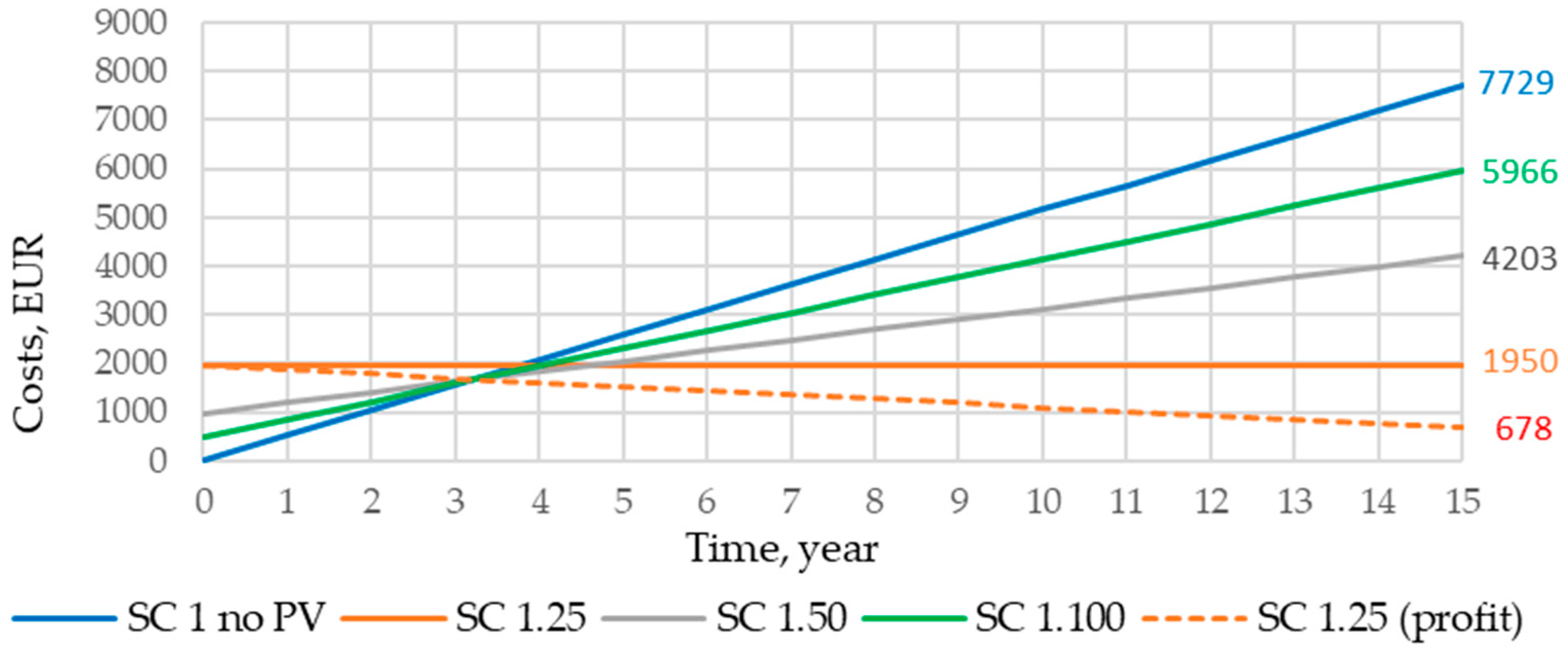

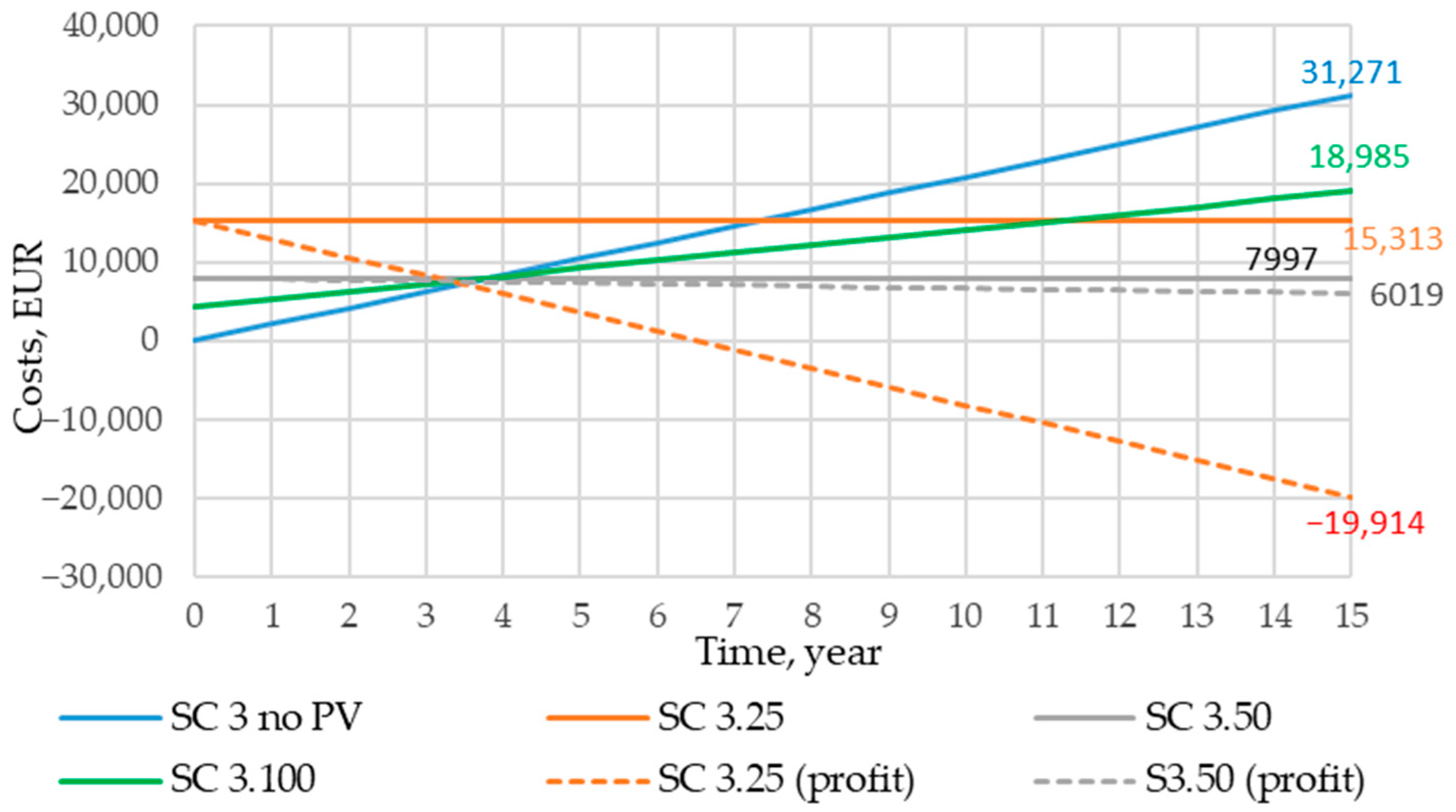
| Year (Average Price, EUR/MWh) | 2021 (88.77 EUR) | 2022 (226.91 EUR) | 2023, (93.89 EUR) | |
|---|---|---|---|---|
| Scenario | ||||
| The total costs per EC memeber after 15 years, EUR | ||||
| SC 1.25 | 3709.35 | 1950.00 | 3669.11 | |
| SC 1.25 profit | - | 678.70 | - | |
| SC 1.50 | 4180.16 | 4203.18 | 4206.30 | |
| SC 1.100 | 4415.56 | 5965.92 | 4474.89 | |
| SC 2 no PV | 7057.13 | 12,074.54 | 7074.00 | |
| SC 2.25 | 6696.79 | 8748.52 | 6649.20 | |
| SC 2.50 | 6876.96 | 10,411.53 | 6861.59 | |
| SC 2.100 | 6967.04 | 11,243.03 | 6967.79 | |
| SC 3 no PV | 14,301.47 | 31,270.96 | 14,901.39 | |
| SC 3.25 | 15,313.17 | 15,313.17 | 15,313.17 | |
| SC 3.25 profit | 8251.86 | −19,913.58 | 7871.04 | |
| SC 3.50 | 11,616.59 | 7996.51 | 11,726.13 | |
| SC 3.50 profit | - | 6018.61 | - | |
| SC 3.100 | 13,298.95 | 18,984.70 | 13,653.68 | |
| The potential benefit per member compared with no PV scenario, EUR | ||||
| SC 1.25 | 941.61 | 5778.66 | 1073.89 | |
| SC 1.25 profit | - | 7050.96 | - | |
| SC 1.50 | 470.80 | 3525.48 | 537.18 | |
| SC 1.100 | 235.40 | 1762.74 | 269.59 | |
| SC 2.25 | 360.34 | 3326.02 | 424.80 | |
| SC 2.50 | 180.17 | 1663.01 | 212.41 | |
| SC 2.100 | 90.09 | 831.51 | 106.21 | |
| SC 3.25 | −1011.70 | 15,957.79 | −411.78 | |
| SC 3.25 profit | 6049.61 | 51,184.53 | 7030.35 | |
| SC 3.50 | 2684.88 | 23,274.38 | 3175.26 | |
| SC 3.50 profit | - | 25,252.34 | - | |
| SC 3.100 | 1002.52 | 12,286.26 | 1247.71 | |
| NPV, EUR | ||||
| SC 1.25 | −466.00 | 2016.41 | −397.87 | |
| SC 1.25 profit | - | 2669.37 | - | |
| SC 1.50 | −233.00 | 1334.68 | −198.94 | |
| SC 1.100 | −116.50 | 667.34 | −99.47 | |
| SC 2.25 | −322.95 | 1199.05 | −289.88 | |
| SC 2.50 | −161.48 | 599.53 | −144.94 | |
| SC 2.100 | −80.74 | 299.76 | −72.47 | |
| SC 3.25 | −7973.53 | 735.35 | −7665.65 | |
| SC 3.25 profit | −4349.61 | 18,814.02 | −3846.28 | |
| SC 3.50 | −2514.73 | 8052.02 | −2263.06 | |
| SC 3.50 profit | - | 9067.09 | - | |
| SC 3.100 | −1597.28 | 4193.62 | −1471.45 | |
References
- European Environmental Agency. Share of Energy Consumption from Renewable Sources in Europe. Available online: https://www.eea.europa.eu/en/analysis/indicators/share-of-energy-consumption-from (accessed on 24 October 2024).
- European Commission. 2023 Country Report—Latvia; Publications Office of the European Union: Luxembourg, 2023. [Google Scholar] [CrossRef]
- Saviuk, I.; Chema, L.; Andras, P.; Katarzyn, R.; Paolo, B. Explicit Demand Response for Small End-Users and Independent Aggregators; Publications Office of the European Union: Luxembourg, 2022. [Google Scholar] [CrossRef]
- Enerģētikas Likums [Energy Law]. Available online: https://likumi.lv/doc.php?id=49833 (accessed on 24 October 2024).
- Koirala, B.; de Koning, N.; Kort, J.; Iannone, A.; Bisconti, P.; Claessens, B.; Bellesini, F.; Mancinelli, E.; Tribbolati, G.; Emil, B.; et al. Deliverable D3.1 Overview of Barriers and Drivers for Consumer Engagement in Demand Response; European Union’s Horizon 2020 Research and Innovation Programme Under Grant Agreement No 957816; BRIGHT Consortium: Kampala, Uganda, 2021. [Google Scholar]
- Lazdins, R.; Mutule, A.; Zalostiba, D. PV Energy Communities—Challenges and Barriers from a Consumer Perspective: A Literature Review. Energies 2021, 14, 4873. [Google Scholar] [CrossRef]
- de Lotto, R.; Micciché, C.; Venco, E.M.; Bonaiti, A.; de Napoli, R. Energy Communities: Technical, Legislative, Organizational, and Planning Features. Energies 2022, 15, 1731. [Google Scholar] [CrossRef]
- Llera-Sastresa, E.; Gimeno, J.Á.; Osorio-Tejada, J.L.; Portillo-Tarragona, P. Effect of Sharing Schemes on the Collective Energy Self-Consumption Feasibility. Energies 2023, 16, 6564. [Google Scholar] [CrossRef]
- Minuto, F.D.; Lanzini, A. Energy-Sharing Mechanisms for Energy Community Members under Different Asset Ownership Schemes and User Demand Profiles. Renew. Sustain. Energy Rev. 2022, 168, 112859. [Google Scholar] [CrossRef]
- Roberts, M.B.; Sharma, A.; MacGill, I. Efficient, Effective and Fair Allocation of Costs and Benefits in Residential Energy Communities Deploying Shared Photovoltaics. Appl. Energy 2022, 305, 117935. [Google Scholar] [CrossRef]
- Li, N.; Hakvoort, R.A.; Lukszo, Z. Cost Allocation in Integrated Ccommunity Energy Systems—Social Accepance. Sustainability 2022, 307, 9951. [Google Scholar] [CrossRef]
- Kulmala, A.; Baranauskas, M.; Safdarian, A.; Valta, J.; Jarventausta, P.; Bjorkqvist, T. Comparing Value Sharing Methods for Different Types of Energy Communities. In Proceedings of the 2021 IEEE PES Innovative Smart Grid Technologies Europe: Smart Grids: Toward a Carbon-Free Future, ISGT Europe 2021, Espoo, Finland, 18–21 October 2021. [Google Scholar] [CrossRef]
- Standal, K.; Dotterud, M.; Alonso, I.; Azevedo, I.; Kudrenickis, I.; Maleki-dizaji, P.; Laes, E.; Rosaria, M.; Nucci, D.; Krug, M. Can Renewable Energy Communities Enable a Just Energy Transition ? Exploring Alignment between Stakeholder Motivations and Needs and EU Policy in Latvia, Norway, Portugal and Spain. Energy Res. Soc. Sci. 2023, 106, 103326. [Google Scholar] [CrossRef]
- Gjorgievski, V.Z.; Cundeva, S.; Georghiou, G.E. Social Arrangements, Technical Designs and Impacts of Energy Communities: A Review. Renew. Energy 2021, 169, 1138–1156. [Google Scholar] [CrossRef]
- Abada, I.; Ehrenmann, A.; Lambin, X. Unintended Consequences: The Snowball Effect of Energy Communities. Energy Policy 2020, 143, 111597. [Google Scholar] [CrossRef]
- Weckesser, T.; Franjo, D.; Blomgren, E.M.V.; Schledorn, A.; Madsen, H. Renewable Energy Communities: Optimal Sizing and Distribution Grid Impact of Photo-Voltaics and Battery Storage. Appl. Energy 2021, 301, 117408. [Google Scholar] [CrossRef]
- Arnould, J.; Quiroz, D. Energy Communities in the EU: Fulfilling Consumer Rights and Protection; The European Consumer Organisation (BEUC): Brussels, Belgium, 2022. [Google Scholar]
- Koltunov, M.; Pezzutto, S.; Bisello, A.; Lettner, G.; Hiesl, A.; van Sark, W.; Louwen, A.; Wilczynski, E. Mapping of Energy Communities in Europe: Status Quo and Review of Existing Classifications. Sustainability 2023, 15, 8201. [Google Scholar] [CrossRef]
- Krug, M.; Nucci, M.R.D.; Caldera, M.; Luca, E. De Mainstreaming Community Energy: Is the Renewable Energy Directive a Driver for Renewable Energy Communities in Germany and Italy? Sustainability 2022, 14, 7181. [Google Scholar] [CrossRef]
- Transposition Tracker. Available online: https://www.rescoop.eu/policy/transposition-tracker (accessed on 24 October 2024).
- Frieden, D.; Tuerk, A.; Antunes, A.R.; Athanasios, V.; Chronis, A.-G.; D’Herbemont, S.; Kirac, M.; Marouço, R.; Neumann, C.; Catalayud, E.P.; et al. Are We on the Right Track? Collective Self-Consumption and Energy Communities in the European Union. Sustainability 2021, 13, 12494. [Google Scholar] [CrossRef]
- Luz, P.; Stephen, H.; Lars, H. Regulatory Challenges and Opportunities for Collective Renewable Energy Prosumers in the EU. Energy Policy 2020, 138, 111212. [Google Scholar] [CrossRef]
- Roberts, J. Power to the People? Implications of the Clean Energy Package for the Role of Community Ownership in Europe’s Energy Transition. Rev. Eur. Comp. Int. Environ. Law 2020, 29, 232–244. [Google Scholar] [CrossRef]
- Losada-Puente, L.; Blanco, J.A.; Dumitru, A.; Sebos, I.; Tsakanikas, A.; Liosi, I.; Psomas, S.; Merrone, M.; Quiñoy, D.; Rodríguez, E. Cross-Case Analysis of the Energy Communities in Spain, Italy, and Greece: Progress, Barriers, and the Road Ahead. Sustainability 2023, 15, 14016. [Google Scholar] [CrossRef]
- Gjorgievski, V.Z.; Velkovski, B.; Francesco Demetrio, M.; Cundeva, S.; Markovska, N. Energy Sharing in European Renewable Energy Communities: Impact of Regulated Charges. Energy 2023, 281, 128333. [Google Scholar] [CrossRef]
- Özgül, S.; Koçar, G.; Erya, A. Energy for Sustainable Development The Progress, Challenges, and Opportunities of Renewable Energy Cooperatives in Turkey. Energy Sustain. Dev. 2020, 59, 107–119. [Google Scholar] [CrossRef]
- Sebi, C. Community Renewable Energy in France: The State of Development and the Way Forward. Energy Policy 2020, 147, 111874. [Google Scholar] [CrossRef]
- Tarpani, E.; Piselli, C.; Fabiani, C.; Pigliautile, I.; Kingma, E.J.; Pioppi, B.; Pisello, A.L. Energy Communities Implementation in the European Union: Case Studies from Pioneer and Laggard Countries. Sustainability 2022, 14, 12528. [Google Scholar] [CrossRef]
- Rahdan, P.; Zeyen, E.; Gallego-Castillo, C.; Victoria, M. Distributed Photovoltaics Provides Key Benefits for a Highly Renewable European Energy System. Appl. Energy 2024, 360, 122721. [Google Scholar] [CrossRef]
- Bódis, K.; Kougias, I.; Jäger-waldau, A.; Taylor, N.; Szabó, S. A High-Resolution Geospatial Assessment of the Rooftop Solar Photovoltaic Potential in the European Union. Renew. Sustain. Energy Rev. 2019, 114, 109309. [Google Scholar] [CrossRef]
- Bernadette, F.; Auer, H.; Friedl, W. Profitability of PV Sharing in Energy Communities: Use Cases for Different Settlement Patterns. Energy 2019, 189, 116148. [Google Scholar] [CrossRef]
- Mehta, P.; Griego, D. Let It Grow: How Community Solar Policy Can Increase PV Adoption in Cities. Energy Policy 2023, 175, 113477. [Google Scholar] [CrossRef]
- Kortetmäki, A.; Ylipaino, J.; Koskela, J.; Kallioharju, K.; Järventausta, P. The Impact of Metering Methods on Collective Self-Consumption: Insights from Multi-Dwelling Buildings in Finland. Energy Build. 2024, 319, 114511. [Google Scholar] [CrossRef]
- Lindberg, M.B.; Inderberg, T.H.J. Just Sharing? Energy Injustices in the Norwegian Solar Policy Mix for Collective Prosuming. Energy Res. Soc. Sci. 2023, 103, 103219. [Google Scholar] [CrossRef]
- Oliva, F.; Moretti, M.; Gallo, E.; Faranda, R. Energy and Economic Comparison of Virtual and Physical Power Sharing. In Proceedings of the IEEE International Conference on Environment and Electrical Engineering and 2023 IEEE Industrial and Commercial Power Systems Europe (EEEIC/I&CPS Europe), Madrid, Spain, 6–9 June 2023; pp. 1–6. [Google Scholar]
- Fina, B.; Fleischhacker, A.; Auer, H.; Lettner, G. Economic Assessment and Business Models of Rooftop Photovoltaic Systems in Multiapartment Buildings: Case Studies for Austria and Germany. J. Renew. Energy 2018, 2018, 9759680. [Google Scholar] [CrossRef]
- Sadales Tīkls: Elektroapgādes Pārskats. Available online: https://sadalestikls.lv/lv/elektroapgades-apskats (accessed on 24 October 2024).
- Oficiālās Statistikas Portāls [Official Statistics Portal]. Available online: https://data.stat.gov.lv/pxweb/en/OSP_PUB/START__POP__MA__MAA/MAA030/ (accessed on 28 October 2024).
- Elektroenerģijas Tirgus Likums [Electricity Market Law]. Available online: https://likumi.lv/ta/id/108834-elektroenergijas-tirgus-likums (accessed on 24 October 2024).
- Sabiedrisko Pakalpojumu Regulešanas Komisija [The Public Utilities Comission of Latvia]. 2022 Annual Report of the Public Utilities Commission of the Republic of Latvia on the National Energy Sector, Prepared for the European Commission; Public Utilities Commission of the Republic of Latvia: Riga, Latvia, 2023. [Google Scholar]
- Carroll, P.; Silva, F.; Tahir, F.; O’Regan, B.; Lyons, P. Smart Meter Reference Load Profiles and Peak Demand Models. In Decision Sciences. DSA ISC 2024; Lecture Notes in Computer Science; Springer: Cham, Switzerland, 2025; Volume 14778. [Google Scholar] [CrossRef]
- Sadales Tīkls Data Sets for Innovative Development. Available online: https://sadalestikls.lv/en/innovation (accessed on 24 October 2024).
- Complete Solar Energy Solution. Available online: https://www.enefit.ee/en/era/taastuvenergia/paikesepaneelid (accessed on 24 October 2024).
- Mathews, D.; Ó Gallachóir, B.; Deane, P. Systematic Bias in Reanalysis-Derived Solar Power Profiles & the Potential for Error Propagation in Long Duration Energy Storage Studies. Appl. Energy 2023, 336, 120819. [Google Scholar] [CrossRef]
- Global Solar Atlas. Available online: https://globalsolaratlas.info/map?c=54.007769,12.348633,5&s=57.421294,25.620117&m=site (accessed on 24 October 2024).
- Sadales Sistēmas Pakalpojuma Tarifi [Distribution System Service Tariffs]. Available online: https://sadalestikls.lv/lv/tarifi (accessed on 24 October 2024).
- Treasury of the Latvian Republic Diskonta Likmes [Discont Rates]. Available online: https://www.kase.gov.lv/metodika/diskonta-likmes (accessed on 24 October 2024).
- Brückmann, G.; Ruprecht, S.; Stadelmann-Steffen, I. Solar for Tenants: Survey Evidence on Design and Framing of Citizen-Financed Photovoltaic Projects in Switzerland. Energy Res. Soc. Sci. 2024, 118, 103819. [Google Scholar] [CrossRef]
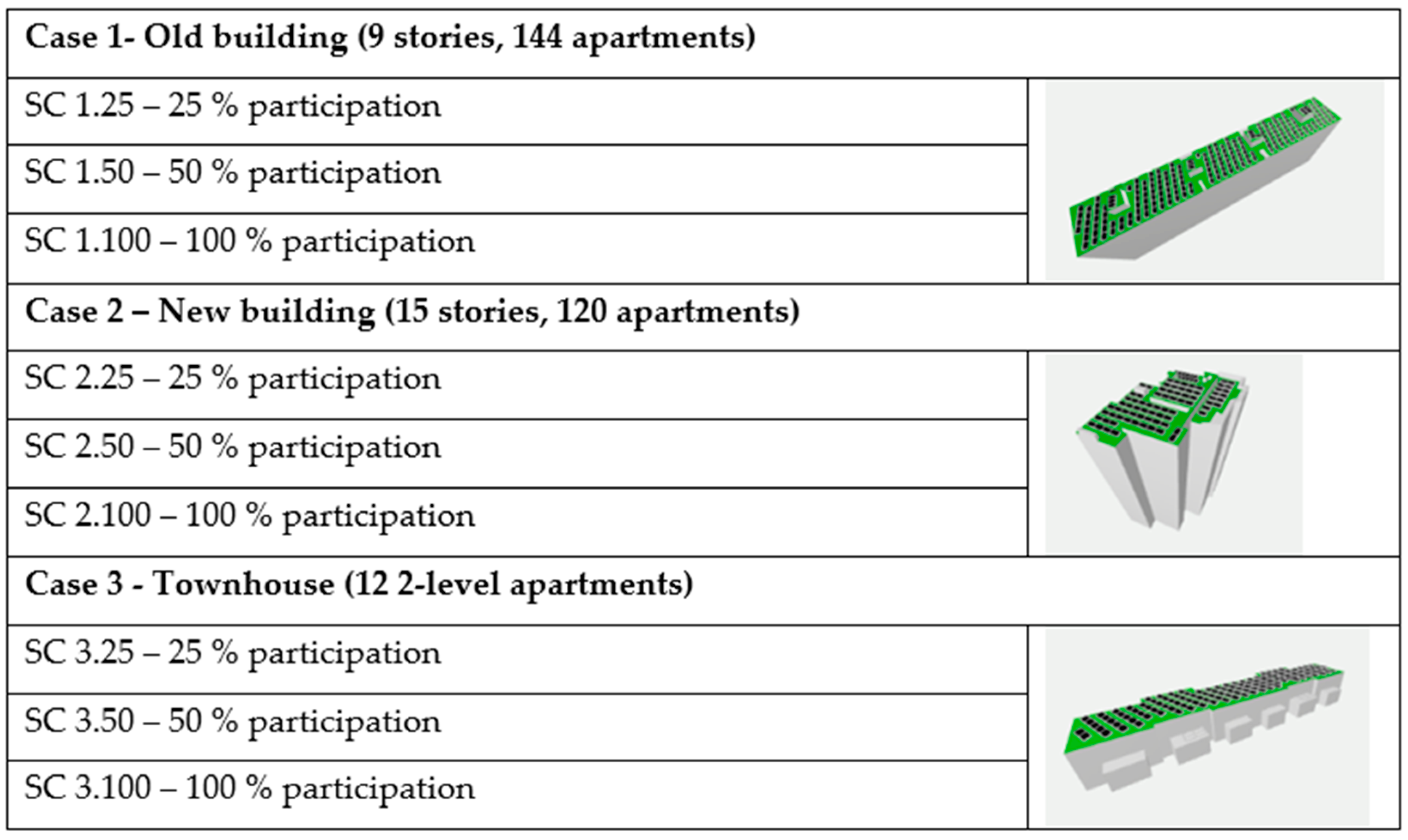
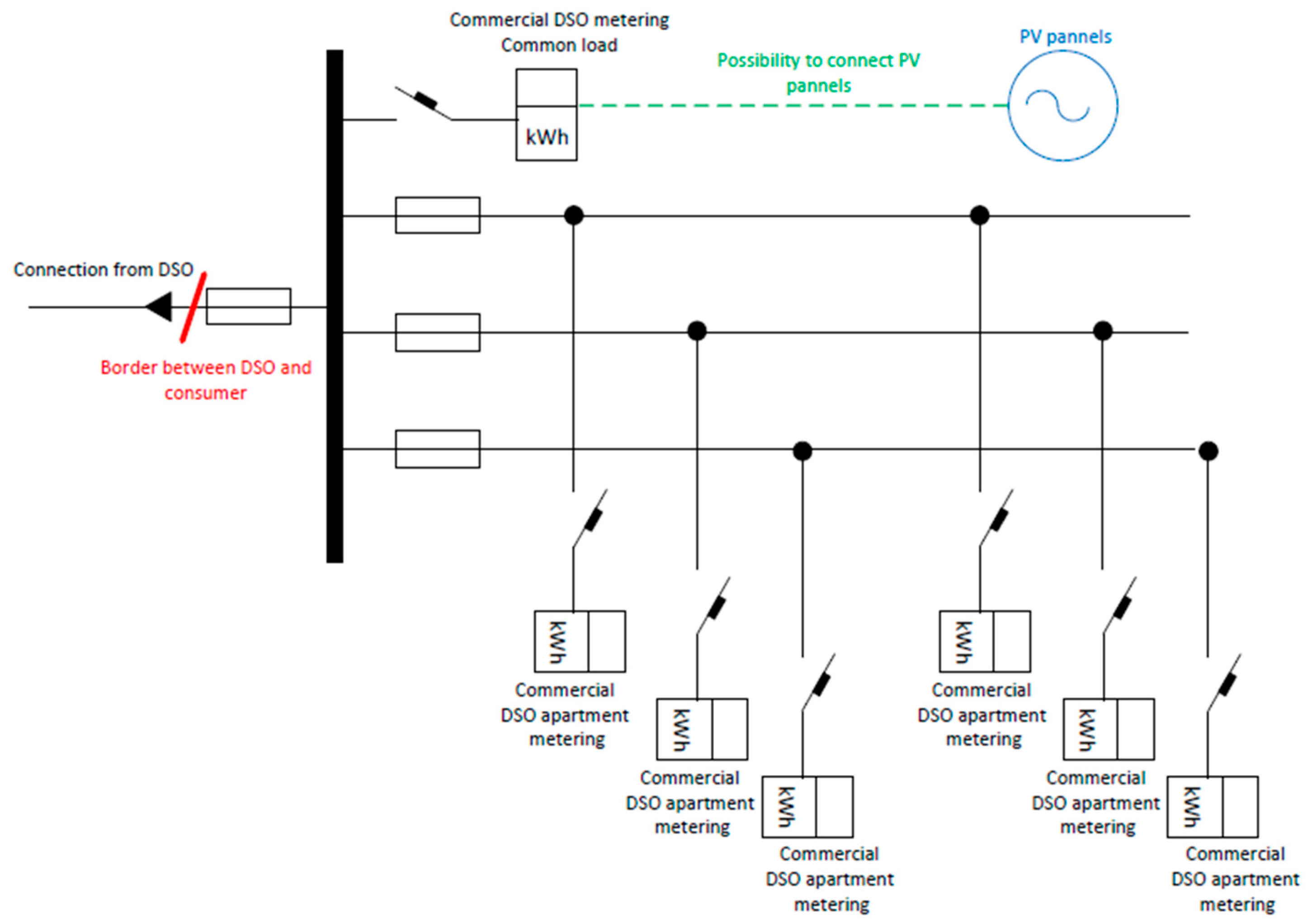
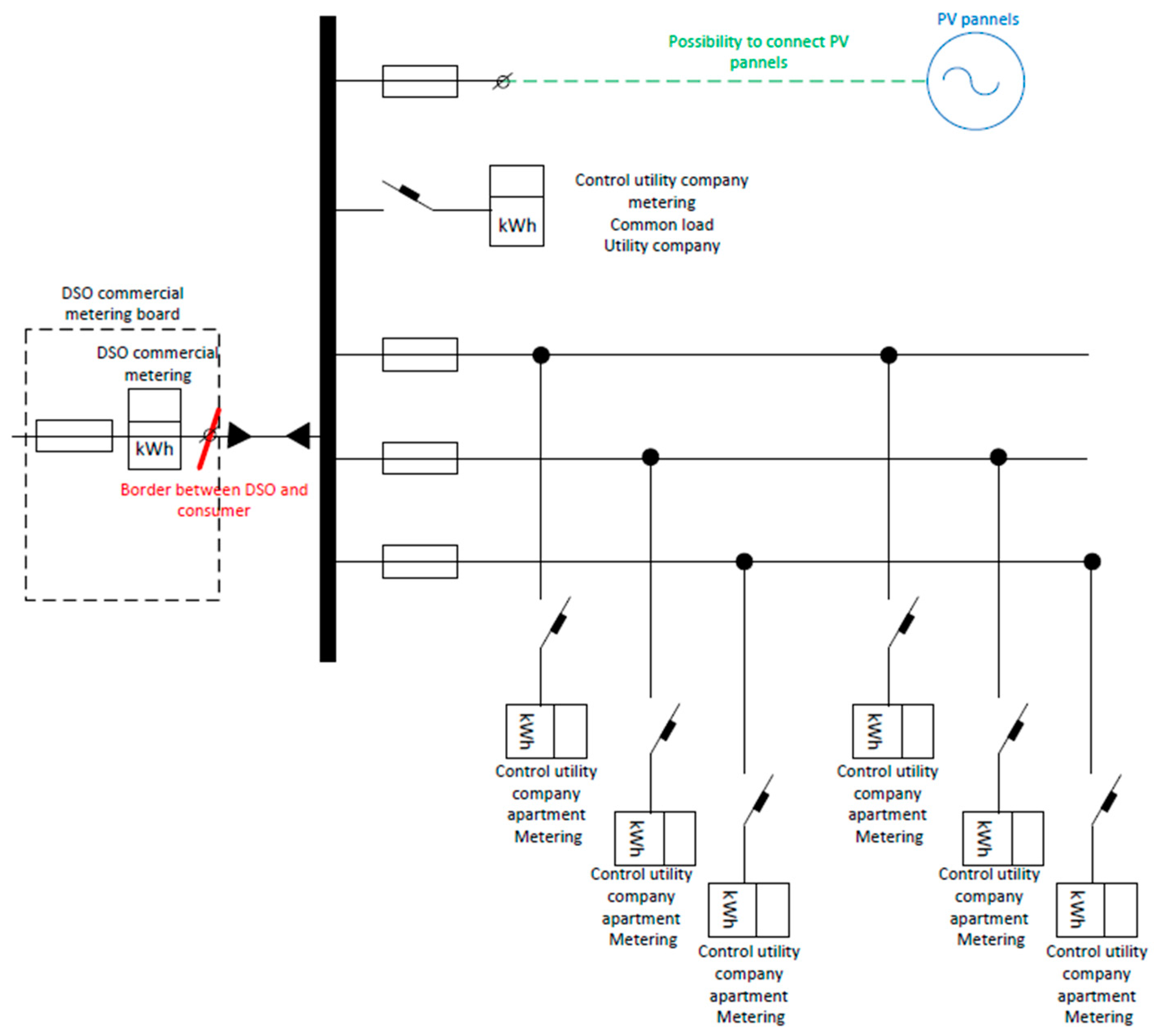
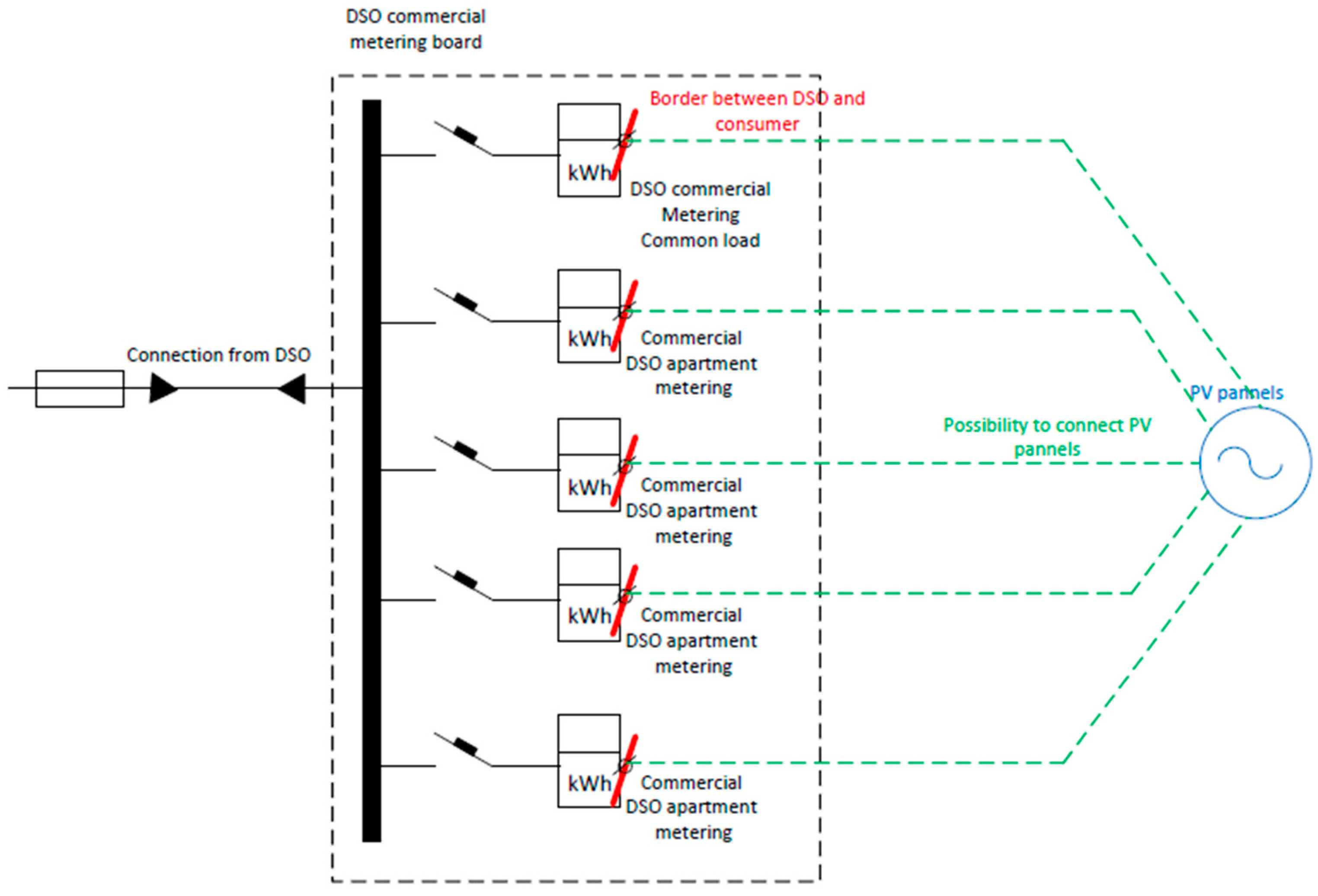
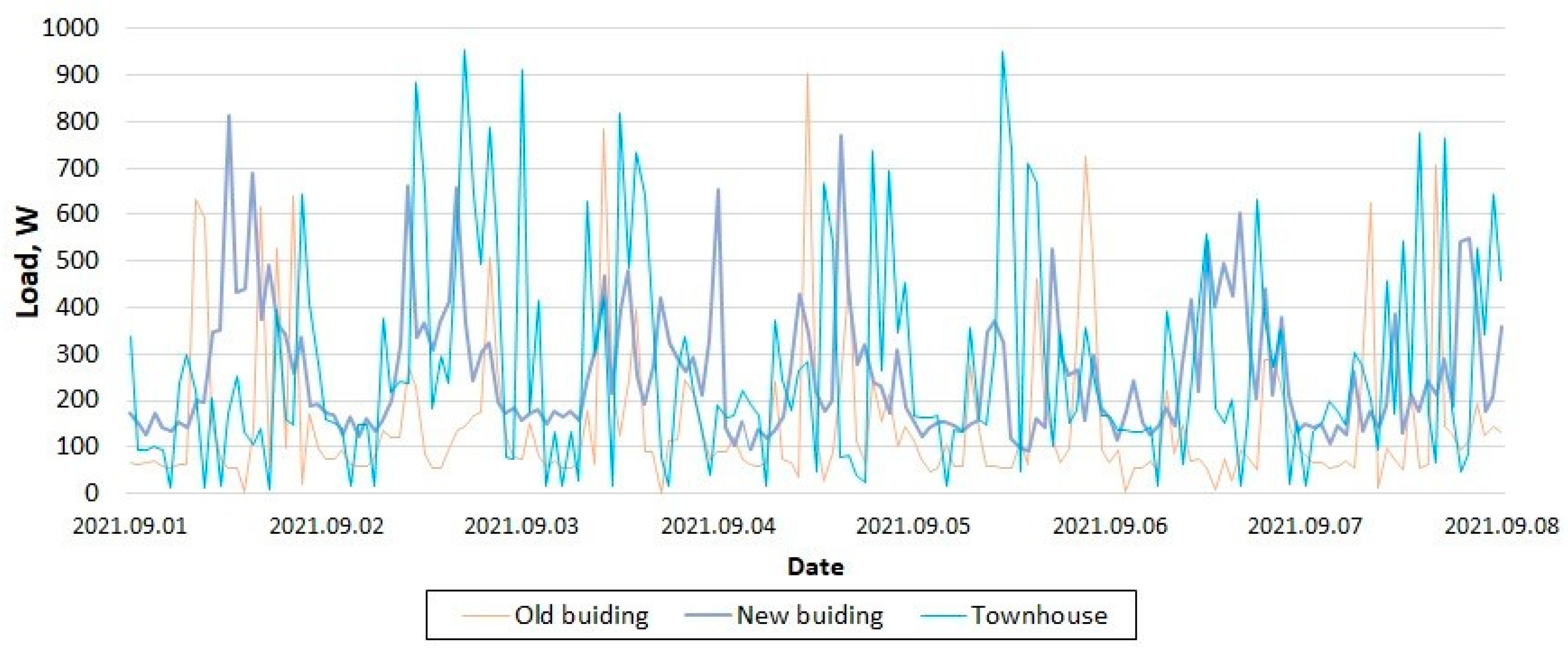
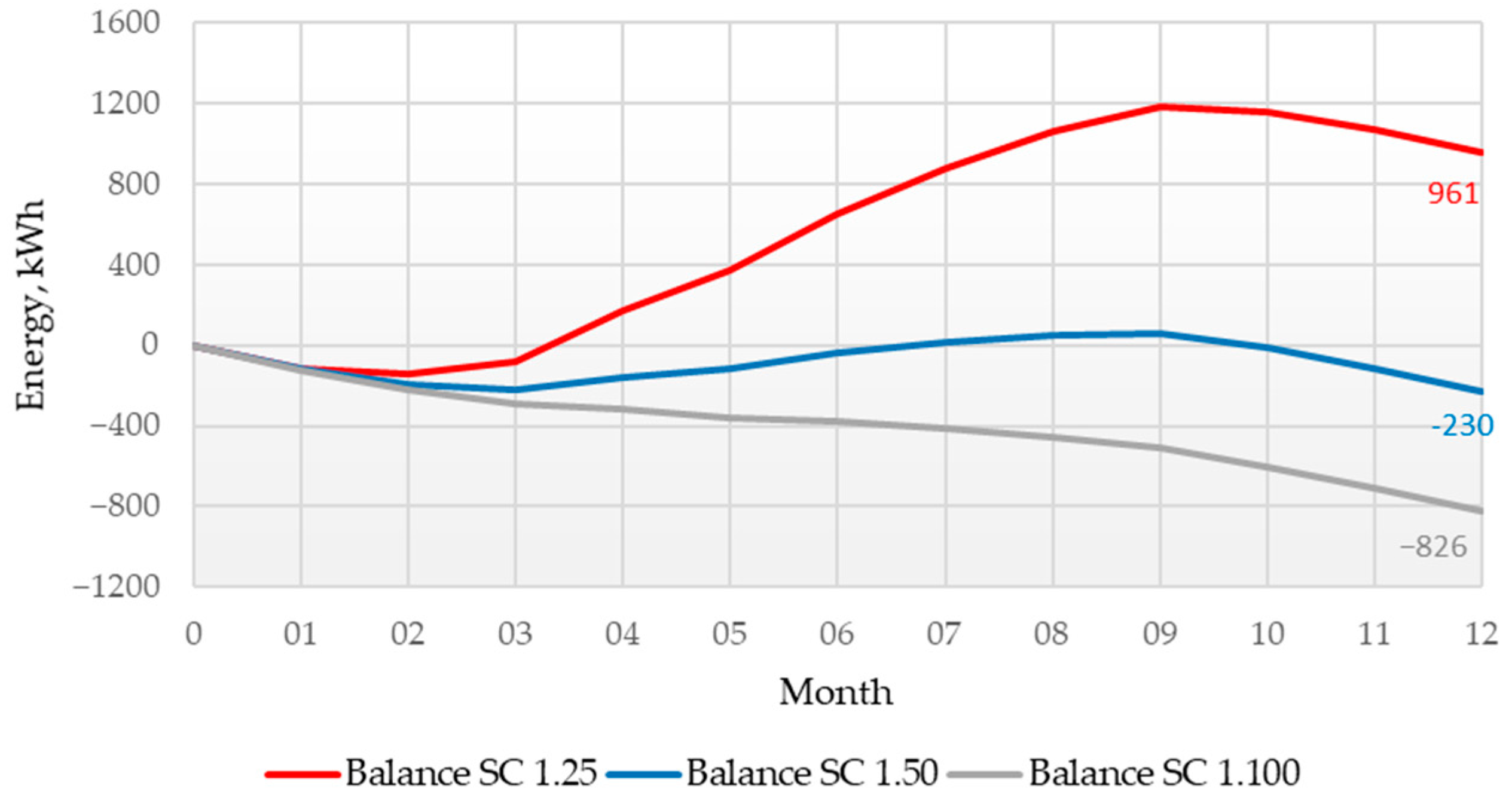
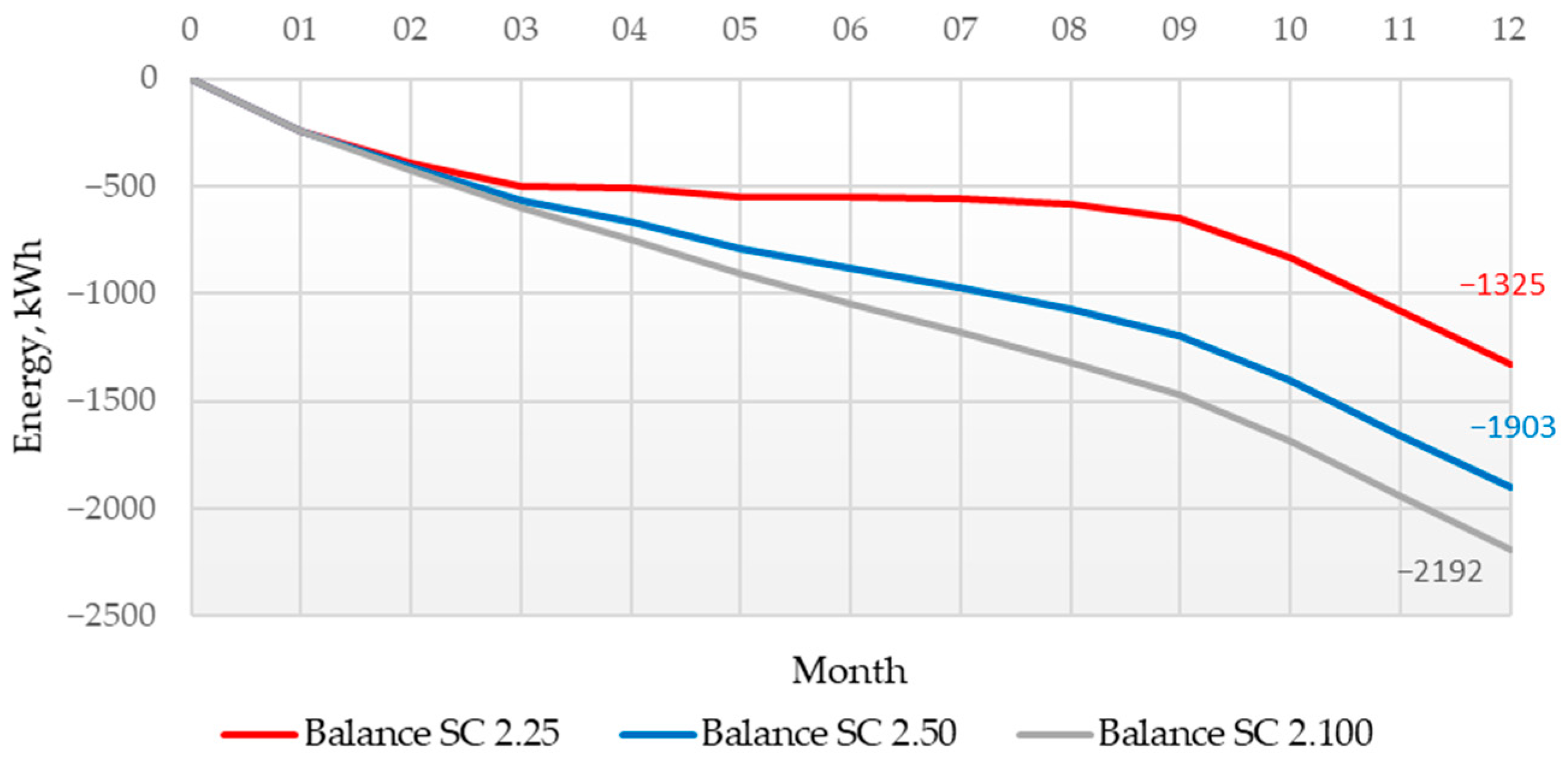
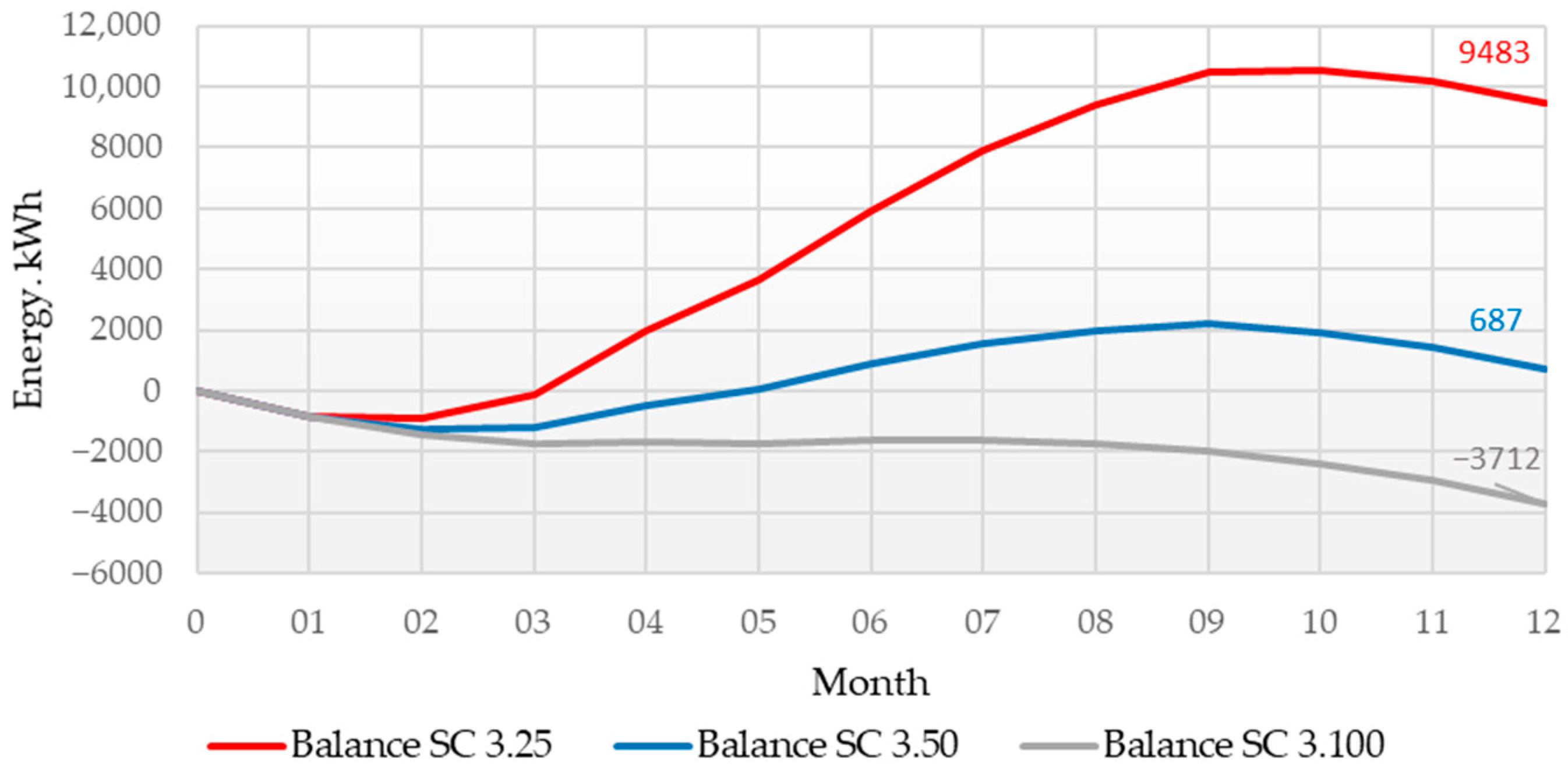

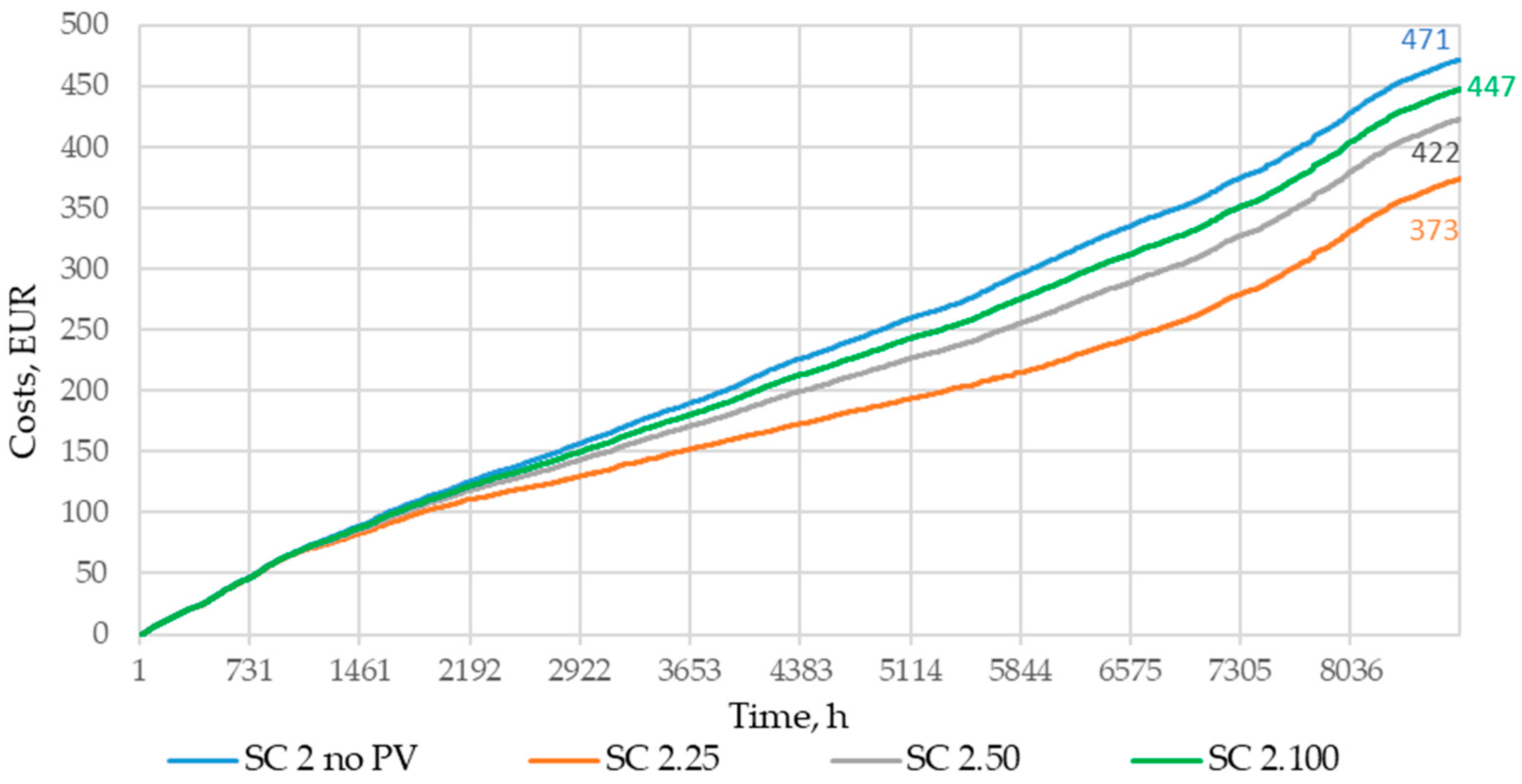
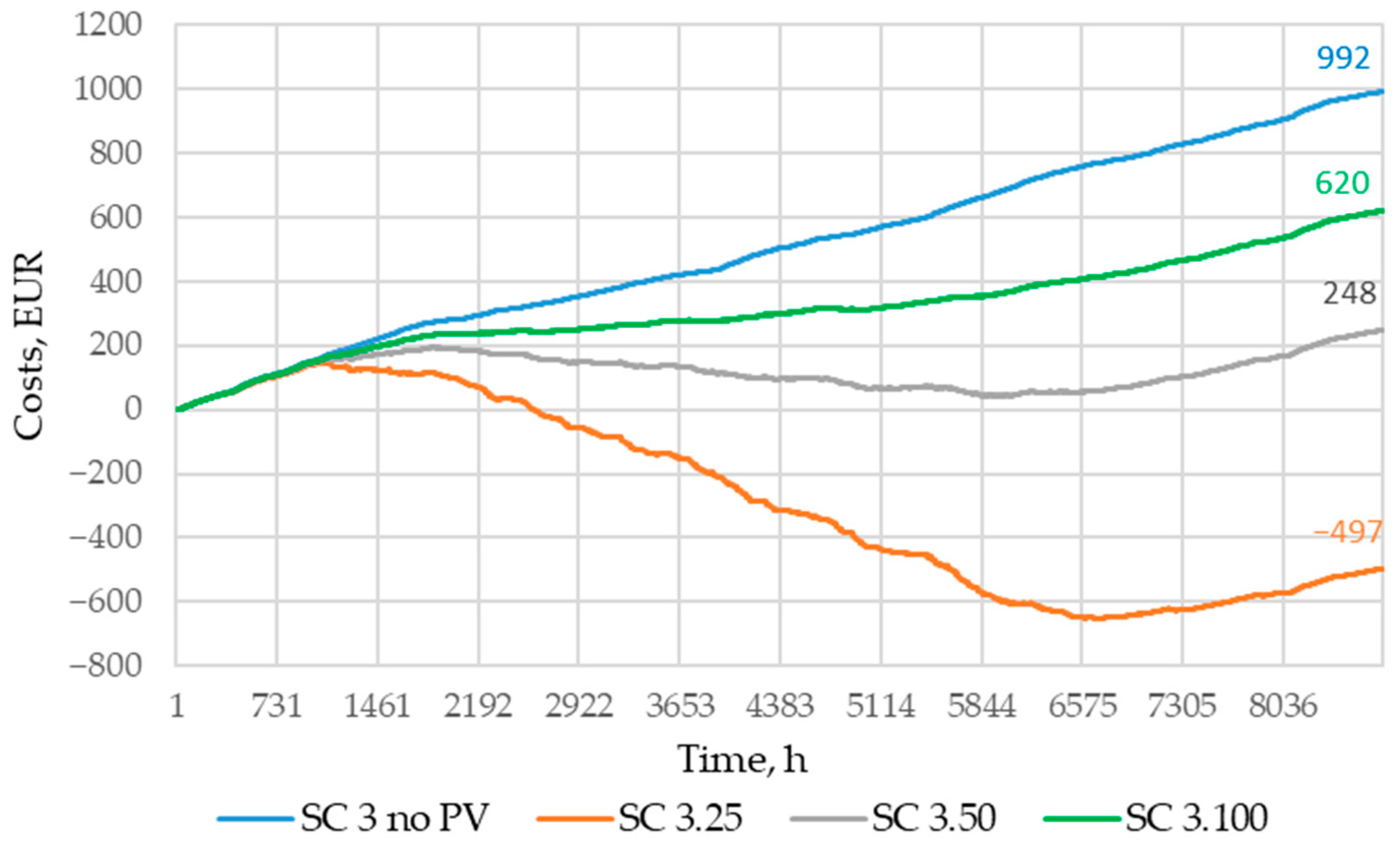
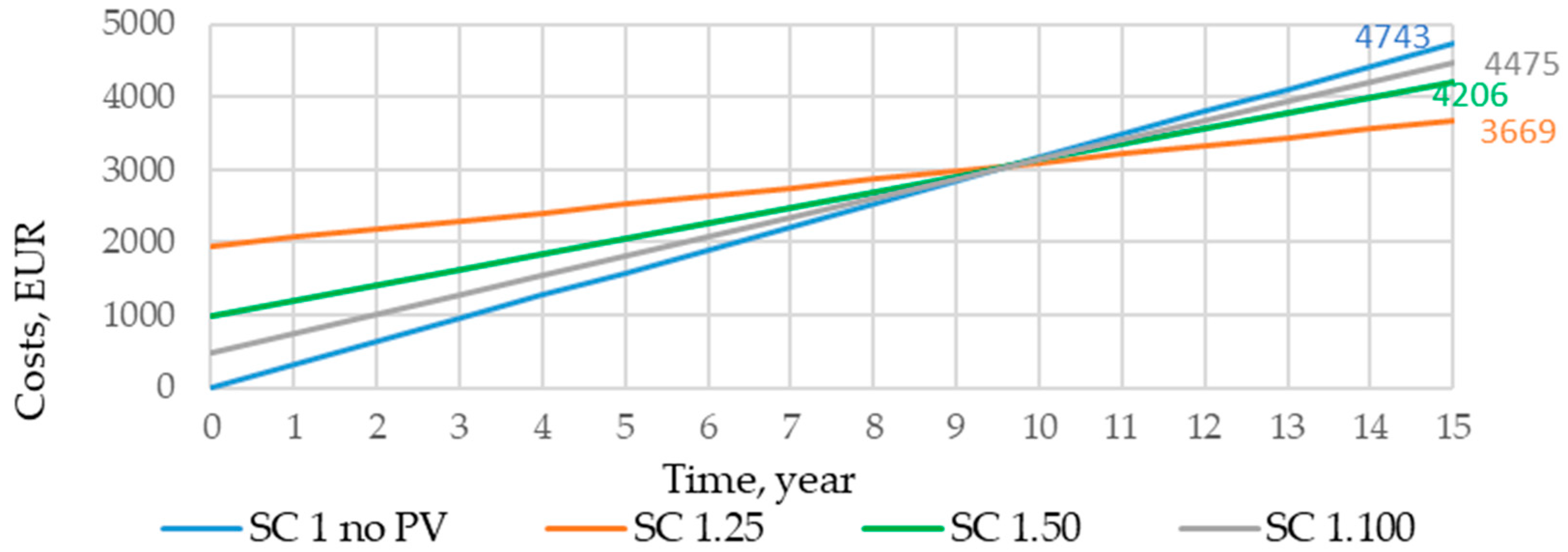
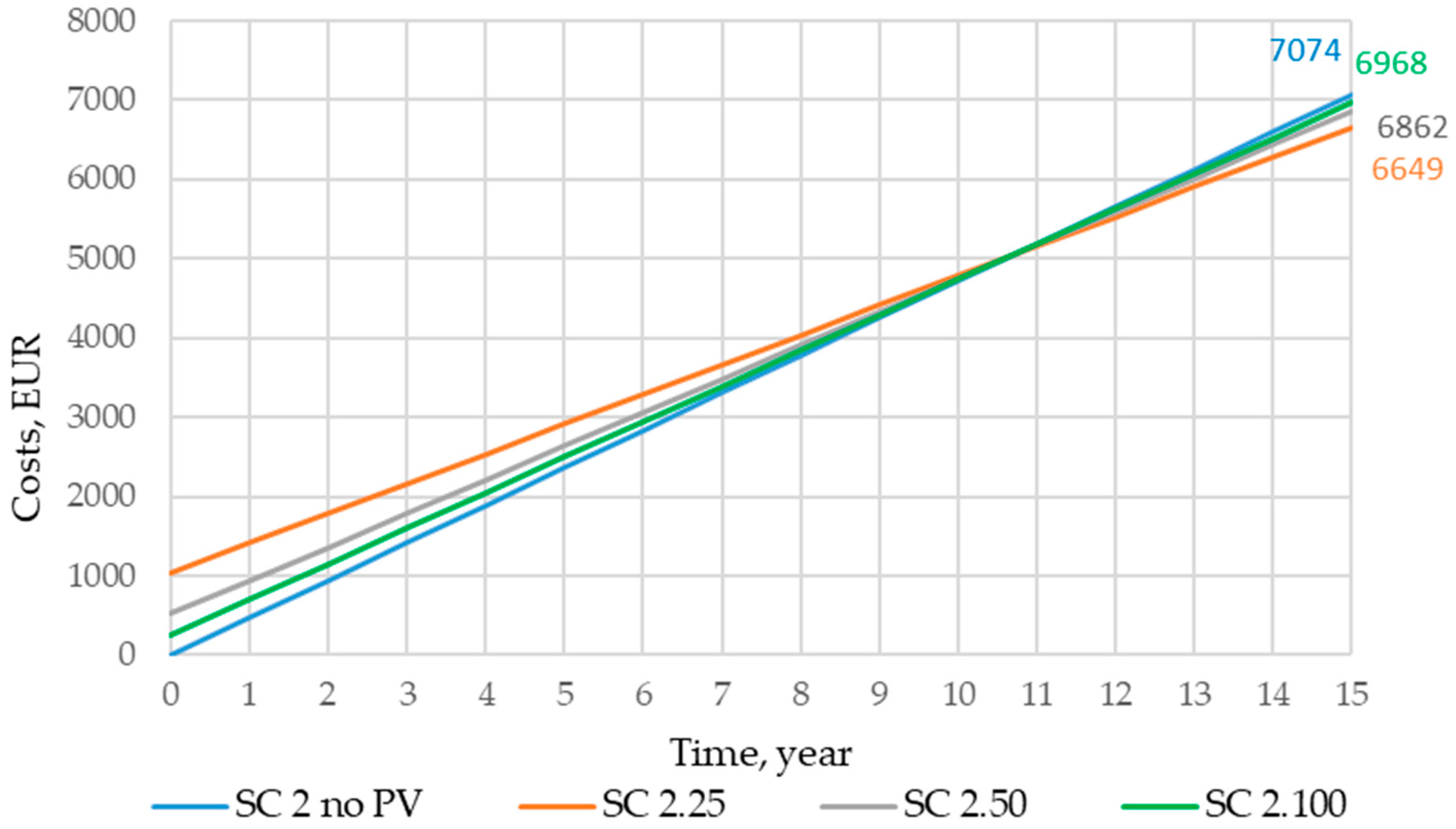
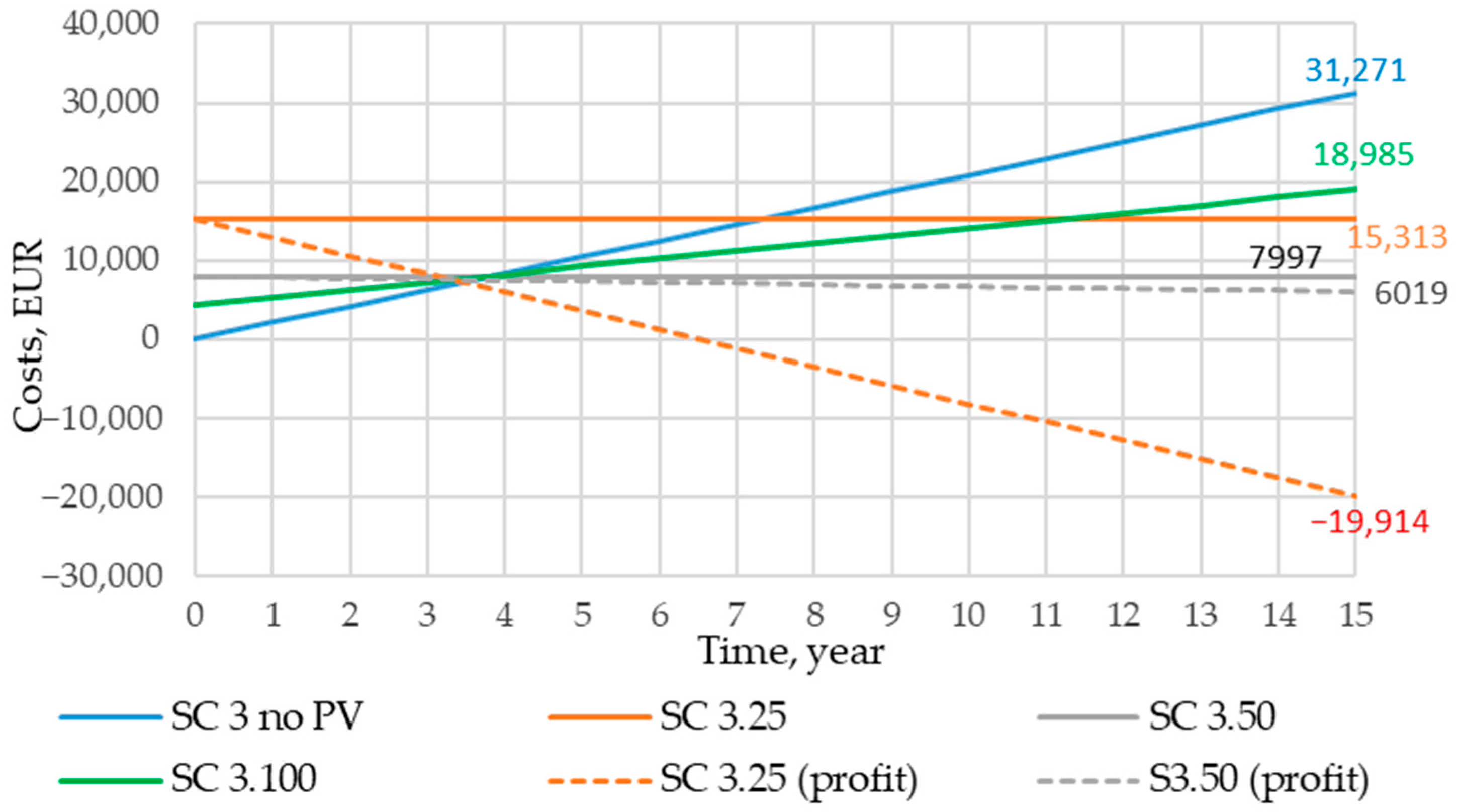
| Case 1: Old Building | Case 2: New Building | Case 3: Townhouse | |
|---|---|---|---|
| Apartment number | 144 | 120 | 12 |
| Number of PV panels | 223 | 90 | 134 |
| Capacity of PV panels, kW | 101.46 | 40.95 | 60.97 |
| Capacity per apartment, kW | 0.7 | 0.35 | 5.08 |
| Estimated yearly consumption, MWh | 181.9 | 297.8 | 70.5 |
| Estimated yearly generation, MWh | 85.73 | 34.68 | 52.78 |
| Installation costs, EUR | 70,200.00 | 31,300.00 | 43,900.00 |
| Scenario | Initial Investment per EC Member, EUR | Cumulative 15-Year Costs per EC Member, EUR | Potential Benefit per EC Member Compared with No PV Scenario, EUR | NPV, EUR |
|---|---|---|---|---|
| SC 1 no PV | 0 | 4743.48 | - | - |
| SC 1.25 | 1950.00 | 3669.11 | 1074.36 | −397.87 |
| SC 1.50 | 975.00 | 4206.30 | 537.18 | −198.94 |
| SC 1.100 | 487.50 | 4474.89 | 268.59 | −99.47 |
| SC 2 no PV | 0 | 7074.00 | - | - |
| SC 2.25 | 1043.33 | 6649.20 | 424.80 | −289.88 |
| SC 2.50 | 521.67 | 6861.59 | 212.41 | −144.94 |
| SC 2.100 | 260.83 | 6967.79 | 106.21 | −72.47 |
| SC 3 no PV | 0 | 14,901.39 | - | - |
| SC 3.25 | 15,313.17 | 15,313.17 | −411.78 | −7665.65 |
| SC 3.25 (profit) | 15,313.17 | 7871.04 | 7030.35 | −3846.28 |
| SC 3.50 | 7996.51 | 11,726.13 | 3175.26 | −2263.06 |
| SC 3.100 | 4338.17 | 13,653.68 | 1247.71 | −1471.45 |
Disclaimer/Publisher’s Note: The statements, opinions and data contained in all publications are solely those of the individual author(s) and contributor(s) and not of MDPI and/or the editor(s). MDPI and/or the editor(s) disclaim responsibility for any injury to people or property resulting from any ideas, methods, instructions or products referred to in the content. |
© 2025 by the authors. Licensee MDPI, Basel, Switzerland. This article is an open access article distributed under the terms and conditions of the Creative Commons Attribution (CC BY) license (https://creativecommons.org/licenses/by/4.0/).
Share and Cite
Mutule, A.; Borscevskis, O.; Astapov, V.; Antoskova, I.; Carroll, P.; Kairisa, E. PV Energy Communities in Residential Apartments: Technical Capacities and Economic Viability. Sustainability 2025, 17, 2901. https://doi.org/10.3390/su17072901
Mutule A, Borscevskis O, Astapov V, Antoskova I, Carroll P, Kairisa E. PV Energy Communities in Residential Apartments: Technical Capacities and Economic Viability. Sustainability. 2025; 17(7):2901. https://doi.org/10.3390/su17072901
Chicago/Turabian StyleMutule, Anna, Olegs Borscevskis, Victor Astapov, Irina Antoskova, Paula Carroll, and Evita Kairisa. 2025. "PV Energy Communities in Residential Apartments: Technical Capacities and Economic Viability" Sustainability 17, no. 7: 2901. https://doi.org/10.3390/su17072901
APA StyleMutule, A., Borscevskis, O., Astapov, V., Antoskova, I., Carroll, P., & Kairisa, E. (2025). PV Energy Communities in Residential Apartments: Technical Capacities and Economic Viability. Sustainability, 17(7), 2901. https://doi.org/10.3390/su17072901






